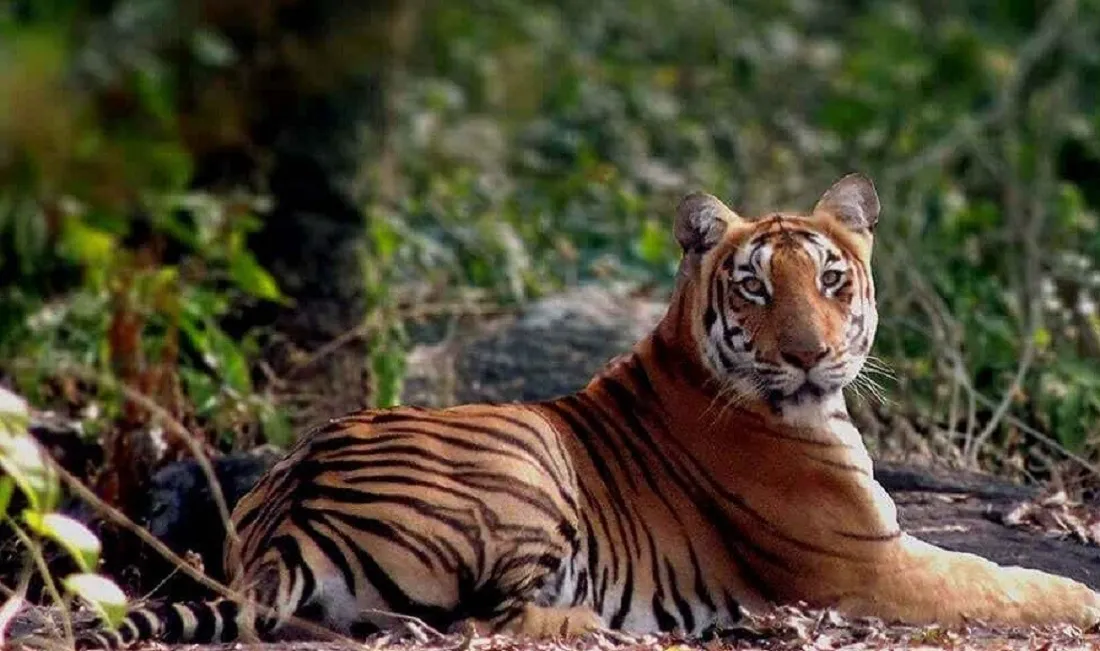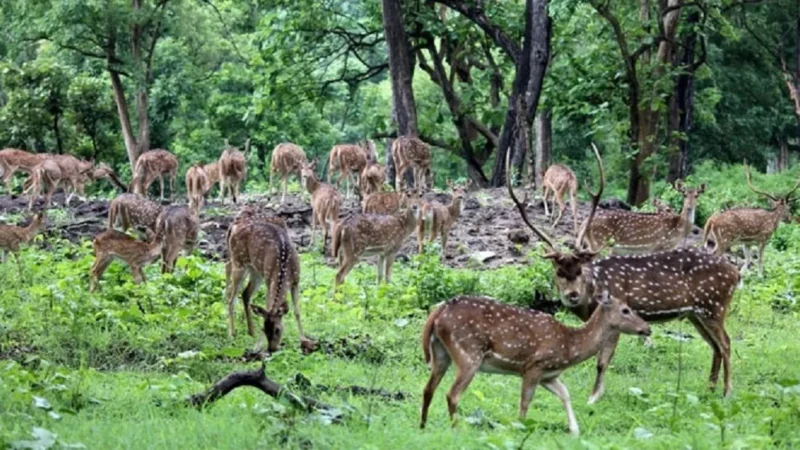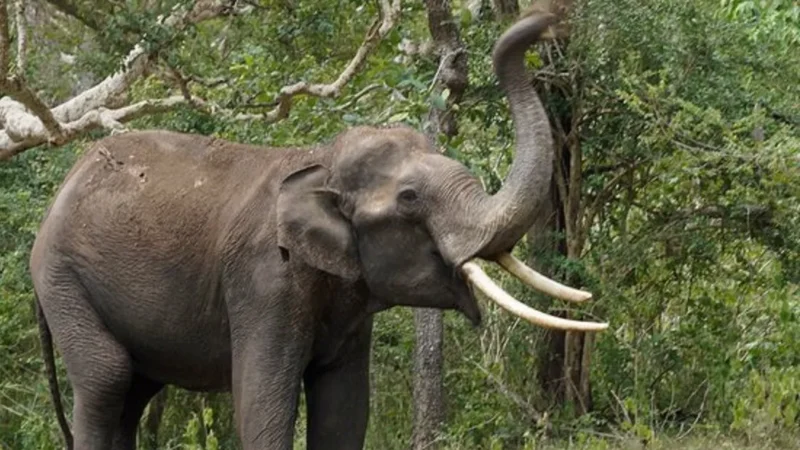15 Best Wildlife Sanctuary in Tamil Nadu

Table of Contents
ToggleTamil Nadu Wildlife Sanctuary
Welcome to a land where the jungles echo the calls of magnificent beasts, the skies are adorned with colorful feathers, and the rivers teem with life. Tamil Nadu, known for its rich cultural heritage and stunning landscapes, also harbors a hidden world of untamed wilderness. Nestled amidst the Western Ghats, coastal plains, and lush forests are some of India’s most enchanting wildlife sanctuaries.
In this blog, we embark on an exhilarating journey to uncover the best wildlife sanctuaries that Tamil Nadu has to offer. From the verdant Nilgiri Hills to the coastal haven of Pulicat Lake, each sanctuary tells a story of nature’s resilience, diversity, and raw beauty. Whether you’re a wildlife enthusiast, an adventure seeker, or simply yearning for a connection with the natural world, Tamil Nadu’s wildlife sanctuaries beckon you.
Tamil Nadu is home to several beautiful and diverse wildlife sanctuaries. Here is a list of the top 15 wildlife sanctuaries in Tamil Nadu:
1- Mudumalai National Park
Mudumalai National Park is a national park in the Nilgiri Mountains in Tamil Nadu, India. It covers 321 km2 (124 sq mi) at an elevation range of 850–1,250 m (2,790–4,100 ft) in the Nilgiri District and shares boundaries with Karnataka and Kerala. A part of this area has been protected since 1940. The national park has been part of Nilgiri Biosphere Reserve since 1986 and was declared a tiger reserve with a buffer zone of 367.59 km2 (141.93 sq mi) in 2007.
Mudumalai National Park is home to a variety of wildlife, including elephants, tigers, leopards, deer, gaur, sloth bears, wild boars, and many species of birds. It is also home to several endangered species, such as the Nilgiri tahr, the lion-tailed macaque, and the Indian pangolin.
The best time to visit Mudumalai National Park is during the summer (June to September) when the weather is pleasant. However, the park can be visited all year round.
There are several things to do in Mudumalai National Park, including:
- Taking a jeep safari: This is the best way to see the wildlife in the park.
- Trekking: Several trekking trails in the park range from easy to challenging.
- Bird watching: The park is home to various migratory birds.
- Camping: There are several campsites in the park.
Mudumalai National Park is a popular tourist destination known for its scenic beauty. It is an essential habitat for wildlife, including elephants, tigers, leopards, and deer.
2- Indira Gandhi Wildlife Sanctuary and National Park
Indira Gandhi Wildlife Sanctuary and National Park is a protected area in the Anaimalai Hills of Pollachi, Valparai and Udumalpet taluks of Coimbatore and Tiruppur districts in Tamil Nadu, India. It was declared a wildlife sanctuary in 1938 and a national park in 1976. It is spread over an area of 958.59 square kilometers.
The park is home to various wildlife, including elephants, tigers, leopards, deer, gaur, sloth bears, wild boars, and many species of birds. It is also home to several endangered species, such as the Nilgiri tahr, the lion-tailed macaque, and the Indian pangolin.
The sanctuary’s main tourist spot is Top Slip, which has an altitude that varies from 350m to 2400 metres above sea level. Here, an attractive variety of fauna and flora can be seen. This terrain has rolling grasslands, wooded hills, deep valleys, and plateaus.
The best time to visit Indira Gandhi Wildlife Sanctuary and National Park is during the summer (June to September), when the weather is pleasant. However, the park can be visited all year round.
There are several things to do in Indira Gandhi Wildlife Sanctuary and National Park, including:
- Taking a jeep safari
- Trekking
- Bird watching
- Camping
Indira Gandhi Wildlife Sanctuary and National Park is a popular tourist destination known for its scenic beauty. It is an important habitat for various wildlife, including elephants, tigers, leopards, and deer.
3- Guindy National Park
Here is some information about Guindy National Park in a different format:
- Location: Guindy National Park is located in Chennai, Tamil Nadu, India.
- Establishment: It was declared as a national park in 1978.
- Area: It is spread over an area of 2.706 square kilometers.
- Vegetation: The park is home to vegetation, including thorn forests, scrub forests, and grasslands.
- Wildlife: The park is home to various wildlife, including blackbuck, spotted deer, sambar deer, lion-tailed macaque, and Indian peafowl.
- Attractions: The park has several attractions, including a children’s park, a snake park, and a boating lake.
- Best time to visit: The park can be visited all year round, but the best time to visit is during the summer months (June to September), when the weather is pleasant.
- How to reach: The park is located in the Guindy area of Chennai and is well connected by road and rail.
Here are some additional details about Guindy National Park:
- The park was originally a game reserve with an area of 5 km square. It was extended to 10 km square in 1957 and 2.706 km square in 1978.
- The park is home to several endangered species, including the blackbuck, the lion-tailed macaque, and the Indian peafowl.
- The park has several educational programs for school children and other visitors.
- The park is a popular tourist destination and is visited by thousands yearly.
4- Annamalai Wildlife Sanctuary
Here is the information about Annamalai Wildlife Sanctuary in the previous style:
- Location: The Annamalai Wildlife Sanctuary is located in the Anaimalai Hills of Pollachi, Valparai and Udumalpet taluks of Coimbatore and Tiruppur districts in Tamil Nadu, India.
- Establishment: It was declared a wildlife sanctuary in 1938 and a national park in 1976.
- Area: It is spread over an area of 958.59 square kilometers.
- Vegetation: The park is home to vegetation, including thorn forests, scrub forests, and grasslands.
- Wildlife: The park is home to various wildlife, including elephants, tigers, leopards, deer, gaur, sloth bears, wild boars, and many species of birds. It is also home to several endangered species, such as the Nilgiri tahr, the lion-tailed macaque, and the Indian pangolin.
- Attractions: The park has several attractions, including Top Slip, whose altitude varies from 350m to 2400 metres above sea level. Here, an attractive variety of fauna and flora can be seen. This terrain has rolling grasslands, wooded hills, deep valleys, and plateaus.
- Best time to visit: The park can be visited all year round, but the best time to visit is during the summer months (June to September), when the weather is pleasant.
- How to reach: The park is located in the Anaimalai Hills and is well connected by road and rail.
5- Kalakkad Mundanthurai Tiger Reserve
Here are some information about the Kalakkad Mundanthurai Tiger Reserve:
- Location: The Kalakkad Mundanthurai Tiger Reserve is in Tirunelveli and Thoothukudi districts of Tamil Nadu, India. [Image of Kalakkad Mundanthurai Tiger Reserve, Tamil Nadu]
- Establishment: It was declared as a tiger reserve in 1988.
- Area: It is spread over an area of 895.04 square kilometers.
- Vegetation: The reserve is home to various vegetation, including dry deciduous forests, moist deciduous forests, and scrub forests.
- Wildlife: The reserve is home to various wildlife, including elephants, tigers, leopards, deer, gaur, sloth bears, wild boars, and many species of birds. It is also home to several endangered species, such as the lion-tailed macaque and the Nilgiri tahr.
- Attractions: The reserve has several attractions, including the Chinnakanal waterfalls, the Kundu waterfalls, and the Kalakkad-Mundanthurai wildlife sanctuary.
- Best time to visit: The reserve can be visited all year round, but the best time to visit is during the summer months (June to September), when the weather is pleasant.
- How to reach: The reserve is located in the Western Ghats and is well connected by road and rail.
Here are some additional details about Kalakkad Mundanthurai Tiger Reserve:
- The reserve was originally created as the Mundanthurai Wildlife Sanctuary in 1962 and the Kalakkad Wildlife Sanctuary in 1976.
- The reserve is home to several endangered species, including the lion-tailed macaque, the only non-human primate found in the Western Ghats.
- The reserve is a popular tourist destination and is visited by thousands yearly.
6- Sathyamangalam Wildlife Sanctuary
Here are some information about the Sathyamangalam Wildlife Sanctuary:
- Location: The Sathyamangalam Wildlife Sanctuary is located at the confluence of the Western Ghats and Eastern Ghats in the Erode district of Tamil Nadu, India.
- Establishment: It was declared as a wildlife sanctuary in 2008 and as a tiger reserve in 2013.
- Area: It is spread over an area of 1,411.6 square kilometers.
- Vegetation: The sanctuary is home to a variety of vegetation, including tropical dry forests, semi-evergreen forests, and thorn forests.
- Wildlife: The sanctuary is home to a variety of wildlife, including elephants, tigers, leopards, deer, gaur, sloth bears, wild boars, and many species of birds. It is also home to a number of endangered species, such as the lion-tailed macaque and the Nilgiri tahr.
- Attractions: The sanctuary has a number of attractions, including the Pykara waterfalls, the Moyar waterfalls, and the Sathyamangalam wildlife sanctuary.
- Best time to visit: The sanctuary can be visited all year round, but the best time to visit is during the summer months (June to September), when the weather is pleasant.
- How to reach: The sanctuary is located in the Sathyamangalam area and is well connected by road and rail.
Here are some additional details about Sathyamangalam Wildlife Sanctuary:
- The sanctuary is home to the highest number of tigers in Tamil Nadu.
- The sanctuary is also home to a number of tribal groups, such as the Irulas and the Soligas.
- The sanctuary is a popular tourist destination and is visited by thousands yearly.
7- Srivilliputhur Grizzled Squirrel Wildlife Sanctuary
Here is the information about Srivilliputhur Grizzled Squirrel Wildlife Sanctuary:
- Location: The Srivilliputhur Grizzled Squirrel Wildlife Sanctuary is located in the Virudhunagar district of Tamil Nadu, India.
- Establishment: It was declared as a wildlife sanctuary in 1988.
- Area: It is spread over an area of 485.2 square kilometers.
- Vegetation: The sanctuary is home to various vegetation, including dry deciduous forests, moist deciduous forests, and scrub forests.
- Wildlife: The sanctuary is home to various wildlife, including elephants, tigers, leopards, deer, gaur, sloth bears, wild boars, grizzled giant squirrel, and many species of birds.
- Best time to visit: The sanctuary can be visited all year round, but the best time to visit is during the summer months (June to September), when the weather is pleasant.
- How to reach: The sanctuary is located in the Srivilliputhur area and is well connected by road and rail.
Here are some additional details about Srivilliputhur Grizzled Squirrel Wildlife Sanctuary:
- The sanctuary is named after the grizzled giant squirrel, the largest squirrel in India and found only in the Western Ghats.
- The sanctuary is also home to several other endangered species, such as the Nilgiri tahr and the lion-tailed macaque.
- The sanctuary is a popular tourist destination and is visited by thousands yearly.
8- Gulf of Mannar Marine National Park
Here is the information about the Gulf of Mannar Marine National Park:
- Location: The Gulf of Mannar Marine National Park is located in the Gulf of Mannar, off the east coast of Tamil Nadu, India.
- Establishment: It was declared as a marine national park in 1986.
- Area: It is spread over an area of 560 km².
- Vegetation: The park is home to a variety of coral reefs, seagrass beds, and mangroves.
- Wildlife: The park is home to a variety of marine life, including coral reefs, sea turtles, dolphins, and dugongs. It is also home to a number of endangered species, such as the hawksbill sea turtle and the dugong.
- Best time to visit: The park can be visited all year round, but the best time to visit is during the summer months (June to September), when the weather is pleasant.
- How to reach: The park is located in the Gulf of Mannar and is well connected by road and rail.
Here are some additional details about Gulf of Mannar Marine National Park:
- The park is home to several islands, including Pambathoppu Island, Mandapam Island, and Katchapanakudi Island.
- The park is a popular tourist destination and is visited by thousands yearly.
- The park is a critical habitat for various endangered species, and its protection is essential for conserving marine biodiversity.
9- Vedanthangal Bird Sanctuary
Here is the information about Vedanthangal Bird Sanctuary in the previous style:
- Location: Vedanthangal Bird Sanctuary is located in the Madurantakam taluk of the Chengalpattu District in Tamil Nadu, India.
- Establishment: It was established as a bird sanctuary in 1936.
- Area: It is spread over 30 hectares (74 acres).
- Vegetation: The sanctuary is home to various vegetation, including marshes, lakes, and scrub forests.
- Wildlife: The sanctuary houses various birds, including pelicans, cormorants, herons, egrets, storks, and flamingos. It is also home to several other animals, such as deer, monkeys, and snakes.
- Best time to visit: The best time to visit the sanctuary is during the winter months (October to March), when the birds arrive from their breeding grounds.
- How to reach: The sanctuary is located about 75 kilometres from Chennai. It is well connected by road and rail.
Here are some additional details about Vedanthangal Bird Sanctuary:
- The sanctuary is the oldest bird sanctuary in India.
- It is home to several endangered species, such as the black-headed ibis, the Eurasian spoonbill, and the painted stork.
- The Tamil Nadu Forest Department manages the sanctuary.
- The best way to reach the sanctuary is by road.
- There is an entrance fee for the sanctuary. The fee is INR 5 for adults and INR 2 for children.
- The sanctuary is open from sunrise to sunset.
10- Kanyakumari Wildlife Sanctuary
Kanyakumari Wildlife Sanctuary is a 402.4 km2 (155.4 sq mi) protected area in Kanyakumari district, Tamil Nadu, South India, declared in February 2008. The area is a tiger habitat. Seven rivers originate in the forest, including the Thamirabarani and Pahrali Rivers.
The sanctuary is home to wildlife, including tigers, elephants, lion-tailed macaques, Indian bison, sambar deer, and nilgiri tahr. It is also home to several birds, reptiles, and amphibians.
The best time to visit the sanctuary is during the summer months (April to June), when the weather is dry and the animals are more active.
The sanctuary is open from sunrise to sunset. There is an entrance fee for the sanctuary. The fee is INR 5 for adults and INR 2 for children.
Here are some things to do in Kanyakumari Wildlife Sanctuary:
- Take a jeep safari: This is the best way to see the wildlife in the park.
- Trekking: Several trekking trails in the park range from easy to challenging.
- Bird watching: The park is home to various migratory birds.
- Camping: There are several campsites in the park.
The sanctuary is located about 100 kilometers from Thiruvananthapuram, the capital of Tamil Nadu. It is well connected by road and rail.
11- Point Calimere Wildlife and Bird Sanctuary
Here is the information about Point Calimere Wildlife and Bird Sanctuary
Location: Point Calimere Wildlife and Bird Sanctuary is a protected area in Tamil Nadu, India, that was established in 1967 to protect the endangered blackbuck antelope.
Area: The sanctuary is located at the southeastern tip of Nagapattinam District, on the Palk Strait, where it meets the Bay of Bengal. It is spread over an area of 21.47 square kilometers.
Wildlife
- The sanctuary is home to a variety of wildlife, including:
- Blackbuck antelope
- Gaur
- Spotted deer
- Sambar
- Wild boar
- Many species of birds, including the spoonbill sandpiper and the grey pelican.
Things to do
- Take a jeep safari: This is the best way to see the wildlife in the sanctuary.
- Go bird watching: The sanctuary is home to various birds, so this is a great way to see them up close.
- Take a boat ride: This is a great way to explore the sanctuary and see the wildlife differently.
How to visit
- To visit Point Calimere Wildlife and Bird Sanctuary, you must obtain a permit from the forest department. You can get the permit from the forest office in Nagapattinam.
- The sanctuary is open from sunrise to sunset.
12- Megamalai Wildlife Sanctuary
Here is the information about Megamalai Wildlife Sanctuary:
Location: Megamalai Wildlife Sanctuary is a protected area in Tamil Nadu, India, that was established in 2021.
Area: The sanctuary is located in the Theni district of Tamil Nadu and is spread over an area of 63,000 hectares.
Wildlife
- The sanctuary is home to a variety of wildlife, including:
- Tiger
- Leopard
- Nilgiri tahr
- Gaur
- Spotted deer
- Sambar
- Wild boar
- Malabar giant squirrel
- Lion-tailed macaque
- Common langur
Things to do
- Take a jeep safari: This is the best way to see the wildlife in the sanctuary.
- Go trekking: There are a number of trekking trails in the sanctuary, ranging from easy to challenging.
- Bird watching: The sanctuary is home to a variety of birds, so this is a great way to see them up close.
- Camping: There are a number of campsites in the sanctuary.
How to visit
- To visit Megamalai Wildlife Sanctuary, you will need to obtain a permit from the forest department. You can get the permit from the forest office in Theni.
- The sanctuary is open from sunrise to sunset.
13- Vellode Bird Sanctuary
Here is the information about Vellode Bird Sanctuary:
- Location: Vellode Bird Sanctuary is located in Erode District, Tamil Nadu, India.
- Establishment: It was established as a bird sanctuary in 1996.
- Area: It is spread over 0.77 square kilometers (0.30 sq mi).
- Vegetation: The sanctuary is home to a variety of vegetation, including marshes, lakes, and scrub forests.
- Wildlife: The sanctuary is home to a variety of birds, including pelicans, cormorants, herons, egrets, storks, and flamingos. It is also home to a number of other animals, such as deer, monkeys, and snakes.
- Best time to visit: The best time to visit the sanctuary is during the winter months (October to March), when the birds arrive from their breeding grounds.
- How to reach: The sanctuary is located about 12 kilometers from Erode. It is well connected by road and rail.
The Vellode Bird Sanctuary is a necessary staging and breeding ground for migratory birds on the Central Asian Flyway. It is also home to several resident species of birds. The sanctuary is a popular destination for birdwatchers and nature lovers.
Here are some things to do in Vellode Bird Sanctuary:
- Go bird watching: The sanctuary is home to a variety of birds, so this is a great way to see them up close.
- Take a boat ride on the lake: This is a great way to get a closer look at the birds and other wildlife in the sanctuary.
- Visit the watchtowers: The watchtowers offer a good vantage point to see the birds and other wildlife in the sanctuary.
- Take a walk or hike through the sanctuary: This is a great way to explore the sanctuary and see the different habitats.
The entry fee for the sanctuary is INR 25 for adults and INR 15 for children. The sanctuary is open from sunrise to sunset.
14- Pulicat Lake Bird Sanctuary
Here is some information about Pulicat Lake Bird Sanctuary:
- Location: Pulicat Lake Bird Sanctuary is located in the Tirupati district of Andhra Pradesh and the Thiruvallur district of Tamil Nadu, India.
- Establishment: It was established as a bird sanctuary in 1981.
- Area: It is spread over 759 square kilometers (293 sq mi).
- Vegetation: The sanctuary is home to various vegetation, including marshes, lakes, and scrub forests.
- Wildlife: The sanctuary is home to various birds, including flamingos, pelicans, cormorants, herons, egrets, storks, and many other species. It is also home to several animals, such as deer, monkeys, and snakes.
- Best time to visit: The best time to visit the sanctuary is during the winter months (October to March), when the birds arrive from their breeding grounds.
- How to reach: The sanctuary is about 60 kilometers from Chennai and 120 kilometers from Tirupati. It is well connected by road and rail.
The Pulicat Lake Bird Sanctuary is a necessary staging and breeding ground for migratory birds on the Central Asian Flyway. It is also home to several resident species of birds. The sanctuary is a popular destination for birdwatchers and nature lovers.
Here are some things to do in Pulicat Lake Bird Sanctuary:
- Go bird watching: The sanctuary is home to various birds, so this is a great way to see them up close.
- Take a boat ride on the lake: This is a great way to get a closer look at the birds and other wildlife in the sanctuary
- Visit the watchtowers: The watchtowers offer a good vantage point to see the birds and other wildlife in the sanctuary.
- Take a walk or hike through the sanctuary: This is a great way to explore and see the different habitats.
The entry fee for the sanctuary is INR 25 for adults and INR 15 for children. The sanctuary is open from sunrise to sunset.
15- Kodaikanal Wildlife Sanctuary
Here is some information about Kodaikanal Wildlife Sanctuary:
- Location: Kodaikanal Wildlife Sanctuary is located in the Palani Hills of the Western Ghats in Tamil Nadu, India.
- Area: It is spread over 700 square kilometers (270 sq mi).
- Vegetation: The sanctuary is home to various vegetation, including shola forests, montane grasslands, and scrub forests.
- Wildlife: The sanctuary is home to various wildlife, including elephants, gaur, sambar, spotted deer, Nilgiri tahr, flying squirrels, and various birds.
- Best time to visit: The best time to visit the sanctuary is during the summer months (April to June), when the weather is cool and dry.
- How to reach: The sanctuary is located about 15 kilometers from Kodaikanal. It is well connected by road and rail.
The Kodaikanal Wildlife Sanctuary is a popular destination for tourists and nature lovers. There are several activities that you can do in the sanctuary, such as:
- Trekking: Several trekking trails in the sanctuary range from easy to challenging.
- Bird watching: The sanctuary is home to various birds, so this is a great way to see them up close.
- Jungle safari: You can also take a jeep safari to explore the sanctuary and see the wildlife.
- Visit the viewpoints: There are a number of viewpoints in the sanctuary, offering stunning views of the surrounding hills and valleys.
The entry fee for the sanctuary is INR 30 for adults and INR 15 for children. The sanctuary is open from sunrise to sunset.
Final Note:
As we bid adieu to our virtual expedition through the best wildlife sanctuaries of Tamil Nadu, we find ourselves humbled by the grandeur of the natural world. These sanctuaries, hidden gems within the state, have not only unveiled the incredible biodiversity of Tamil Nadu but also highlighted the crucial need for their preservation.
From the ancient forests of Mudumalai to the tranquil shores of Pulicat Lake, these sanctuaries have offered us glimpses of untamed beauty, moments of serenity, and encounters with the wild that will forever linger in our hearts. They stand as living testimonies to the wonders of conservation, where dedicated efforts have allowed flora and fauna to flourish.
The untamed beauty of Tamil Nadu’s sanctuaries beckons, waiting to be explored, cherished, and conserved for generations to come. So, let us pledge to be stewards of these wild havens, and may they forever thrive as symbols of our commitment to nature’s enduring legacy.





